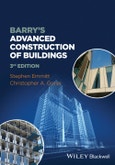The third edition of Barry′s Advanced Construction of Buildings expands and deepens your understanding of construction technology. It covers the construction of larger-scale buildings (primarily residential, commercial and industrial) constructed with load bearing frames, supported by chapters on fit-out and second fix, lifts and escalators, off-site construction and a new chapter on building obsolescence and revitalisation. Functional and performance requirements of the main building elements are emphasised throughout, as is building efficiency and meeting the challenges of limiting the environmental impact of buildings. You will find the text fully up to date with the latest building regulations and construction technologies.
The new edition, with supporting material at
Table of Contents
Acknowledgements viii
About the Companion Website ix
1 Introduction 1
1.1 The function and performance of buildings 1
1.2 New methods and products 8
1.3 Product selection and specification 10
Supporting information 14
2 Scaffolding, Façade Retention and Demolition 15
2.1 Scaffolding 15
2.2 Refurbishment and façade retention 45
2.3 Demolition and disassembly 57
2.4 Reuse and recycled materials 64
3 Ground Stability, Foundations and Substructures 67
3.1 Ground stability 67
3.2 Functional requirements 77
3.3 Foundation types 86
3.4 Substructures and basements 140
4 Single–Storey Frames, Shells and Lightweight Coverings 163
4.1 Lattice truss, beam, portal frame and flat roof structures 163
4.2 Roof and wall cladding, and decking 209
4.3 Rooflights 233
4.4 Diaphragm, fin wall and tilt–up construction 248
4.5 Shell structures 258
5 Structural Steel Frames 273
5.1 Functional requirements 273
5.2 Methods of design 275
5.3 Steel sections 279
5.4 Structural steel frames 284
5.5 Welding 305
5.6 Fire protection of structural steelwork 320
5.7 Floor and roof construction 328
6 Structural Concrete Frames 344
6.1 Concrete 344
6.2 Concrete mixes 349
6.3 Reinforcement 354
6.4 Formwork and falsework 366
6.5 Prestressed concrete 382
6.6 Lightweight concrete 388
6.7 Concrete structural frames 391
6.8 Precast reinforced concrete frames 402
6.9 Lift slab construction 407
7 Cladding and Curtain Wall Construction 411
7.1 Functional requirements 411
7.2 Terms and definitions 419
7.3 Infill wall framing to a structural grid 421
7.4 Solid and cavity walling 423
7.5 Facings applied to solid and cavity wall backing 426
7.6 Cladding panels 437
7.7 Sheet metal wall cladding 460
7.8 Glazed wall systems 468
8 Prefabrication and Off –Site Production 488
8.1 Terms and concepts 488
8.2 Functional requirements 501
8.3 Off –site production 504
8.4 The production process 507
8.5 Pre–cut timber systems 508
8.6 Metal systems 510
8.7 Concrete systems 512
8.8 Joints and joining 513
9 Lifts and Escalators 514
9.1 Functional requirements 514
9.2 Lifts (elevators) 516
9.3 Escalators and moving walkways 528
10 Fit Out and Second Fix 530
10.1 Commercial fit out 530
10.2 Raised floors 532
10.3 Suspended ceilings 536
10.4 Internal partition walls 541
11 Building Obsolescence and Revitalisation 547
11.1 Building obsolescence 547
11.2 Decay, damage and maintenance 551
11.3 Construction defects 553
11.4 Indoor air quality and condensation 554
11.5 Revitalising existing buildings 555
11.6 Retrofitting 560
Appendix A: Websites 562
Appendix B: Additional References 563
Index 565








